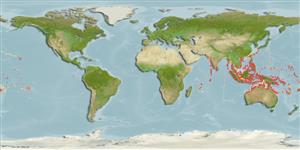>
Eupercaria/misc (Various families in series Eupercaria) >
Haemulidae (Grunts) > Plectorhinchinae
Etymology: Plectorhinchus: Greek, plektos = plaited + Greek, rhyngchos = snout (Ref. 45335).
More on author: Lacepède.
Environment: milieu / climate zone / depth range / distribution range
Sinh thái học
Biển; Thuộc về nước lợ Cùng sống ở rạn san hô; Mức độ sâu 1 - 30 m (Ref. 9710). Tropical; 31°N - 23°S, 57°E - 144°W
Indo_West Pacific: Maldives (Ref. 11303) and Cocos Islands (Ref. 9399); Sumatra to Fiji (Ref. 9710) and New Caledonia, north to Ryukyu Islands, south to Rowley Shoals.
Length at first maturity / Bộ gần gũi / Khối lượng (Trọng lượng) / Age
Maturity: Lm ?, range 40 - ? cm
Max length : 72.0 cm TL con đực/không giới tính; (Ref. 9710); common length : 60.0 cm SL con đực/không giới tính; (Ref. 37816); Khối lượng cực đại được công bố: 7.0 kg (Ref. 9710)
Các tia vây lưng cứng (tổng cộng) : 11 - 12; Các vây lưng mềm (tổng cộng) : 18 - 20; Tia cứng vây hậu môn: 3; Tia mềm vây hậu môn: 7 - 9. This species is distinguished by the following characters: chin with 6 pores, no median pit; gill rakers on first gill arch 9-12 + 1 + 27-32 = 36-43; D XII (rarely XI),18-20; longest dorsal-fin ray 16-25% of standard length, almost equal to length of soft dorsal-fin base in small specimens, more than 1/2 length of soft dorsal-fin base in adults; lips fleshy, moderately swollen with age; scales ctenoid (rough to touch); lateral line tubed scales about 52-59; body depth 2.4-2.5 in SL; caudal fin deeply forked with broadly rounded lobes in juveniles; only slightly forked to emarginate in adults. Colour of body with numerous dark brown spots, generally larger than pupil; pelvic fins spotted, darkening with age; juveniles brownish with large, well-defined creamy white blotches on body that include brown spots with age; colour gradually changing into a greyish background with large, deep brown spots (Ref. 47695, 90102).
Inhabits coral-rich areas of clear lagoon and seaward reefs. Adults are solitary, near and under ledges or caves by day. Juveniles are found among corals (Ref. 9710). Feeds on crustaceans, mollusks, and fishes at night. Juveniles are used in the aquarium industry (Ref. 9137). Small juveniles may mimic a toxic flatworm (Ref. 9710). Marketed fresh, a small quantity is salted. Large fish have coarse and dry flesh (Ref. 47695).
Life cycle and mating behavior
Maturities | Sự tái sinh sản | Spawnings | Egg(s) | Fecundities | Ấu trùng
Oviparous, distinct pairing during breeding (Ref. 205).
Myers, R.F., 1991. Micronesian reef fishes. Second Ed. Coral Graphics, Barrigada, Guam. 298 p. (Ref. 1602)
IUCN Red List Status (Ref. 130435)
Threat to humans
Harmless
Human uses
Các nghề cá: buôn bán nhỏ; Bể nuôi cá: Tính thương mại
Các công cụ
Special reports
Download XML
Các nguồn internet
Estimates based on models
Preferred temperature (Ref.
123201): 25.5 - 29.3, mean 28.6 °C (based on 2654 cells).
Phylogenetic diversity index (Ref.
82804): PD
50 = 0.5000 [Uniqueness, from 0.5 = low to 2.0 = high].
Bayesian length-weight: a=0.01778 (0.01078 - 0.02935), b=2.97 (2.83 - 3.11), in cm total length, based on LWR estimates for this species & (Sub)family-body (Ref.
93245).
Mức dinh dưỡng (Ref.
69278): 3.8 ±0.60 se; based on food items.
Thích nghi nhanh (Ref.
120179): thấp, thời gian nhân đôi của chủng quần tối thiểu là 4.5 - 14 năm (Preliminary K or Fecundity.).
Fishing Vulnerability (Ref.
59153): Moderate to high vulnerability (49 of 100).
Nutrients (Ref.
124155): Calcium = 23.4 [10.8, 51.3] mg/100g; Iron = 0.448 [0.229, 0.851] mg/100g; Protein = 19.3 [17.4, 21.3] %; Omega3 = 0.0978 [, ] g/100g; Selenium = 32.8 [16.8, 63.1] μg/100g; VitaminA = 42.6 [12.0, 152.2] μg/100g; Zinc = 0.972 [0.626, 1.520] mg/100g (wet weight);
